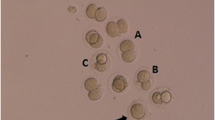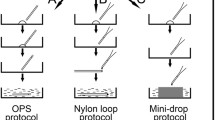Background
Although cryopreservation of human preembryos has been carried out with success, the cryostorage of oocytes, which pose fewer controversial moral, ethical, and legal problems has been much less successful. Various attempts to cryopreserve human oocytes have been mostly unsuccessful and the search for an optimal protocol for oocyte cryopreservation remains elusive. We therefore undertook this study to determine the effect of oocyte cryostorage in 1,2-propanediol.
Method
Mature human oocytes with or without their cumuli were cryopreserved in precooled 1,2-propanediol, then thawed and inseminated with sperms for in vitro fertilization. The outcome of insemination and subsequent embryonic development were also recorded and compared.
Results
Postthaw cryosurvival rate was significantly better when cryostorage was carried out with the oocyte cumulus intact as compared to those oocytes denuded of their cumuli (54 versus 27%, respectively; P <0.05). Eight (44%) of 18 surviving postthaw oocytes with intact cumuli were fertilized normally, with cleavage in six, as compared to two (25%) and one, respectively, of those denuded of their cumulus prior to cryostorage. Development to the blastocyst stage was achieved in three embryos derived from oocytes with an intact cumulus at cryostorage.
Conclusion
We conclude that 1,2-propanediol can be used with success in oocyte cryopreservation, although the issue of parthenogenecity is still to be resolved. Oocyte's with intact cumulus survive cryostorage better than those without it.
Similar content being viewed by others
References
Trounson A, Mohr L: Human pregnancy following cryopreservation thawing and transfer of an eight cell embryo. Nature 1983;305:707–709.
Fehilly CB, Cohen J, Simons RF, Fischel SB, Edwards RG: Cryopreservation of cleaving embryos and expanded blastocysts in human: a comparative study. Fertil Steril 1985;44:638–644.
Testart J, Lasalle B, Belaisch-Allart J, Hazout A, Forman R, Rainhorn JD, Frydman R: High pregnancy rate after early human embryo freezing. Fertil Steril 1986;46:268–272.
Cohen J, De Vane GW, Elsner CW, Fehilly CB, Kort HI, Massey JB, Turner TG: Cryopreservation of zygotes and early cleaved human embryos. Fertil Steril 1988;49:283–289
Chen C: Pregnancy after human oocyte cryopreservation. Lancet 1986;1:884–886
Van Uem JFHM, Siebzehnrubi ER, Schuc B, Koch R, Trotnow S, Lang N: Birth after cryopreservation of unfertilized oocyte. Lancet 1987;2:752–753
Al-Hasani S, Diedrich K, Van der Ven H, Reinecke A, Hartje M, Krebs M: Cryopreservation of human oocytes. Hum Reprod 1987;2:695–700
Mandelbaum J, Junca AM, Plachot M, Alnot MO, Salat-Baroux J, Alvarez S, Tibi C, Cohen J, Debache C, Tesquier: Cryopreservation of human embryos and oocytes. Hum Reprod 1988;3:117–119
Trounson A, Kirby C: Problems in cryopreservation of unfertilized eggs by slow cooling in dimethyl sulfoxide. Fertil Steril 1989;52:778–786
Feichtinger W, Benko I, Kameter P: Freezing human oocytes using rapid technique.In Future Aspects of Human in Vitro Fertilization. Feichtinger W, Kameter P (eds). Berlin, Springer-Verlag, 1987, pp 101–109
Mandelbaum J, Junca AM, Plachot M, Alnot MO, Tibi C, Cohen J, Salat-Baroux J: Cryopreservation of human embryos and oocytes using 1,2-propanediol with or without sucrose as cryoprotectant agents.In Workshop on Human Embryo and Oocyte Freezing. Menezo Y, Merieux C (eds). Annecy, France, 1986, pp 95–105
Kola I, Kirby C, Shaw J, Davey A, Trounson A: Vitrification of mouse oocytes results in aneuploid zygotes and malformed fetuses. Teratology 1988;38:467
Sathananthan AH, Trounson A, Freeman L, Brady T: The effect of cooling human oocytes. Hum Reprod 1988;3:968–977
Al-Hasani S, Tolkdorf A, Diedrich K, Van der Ven H, Krebs D: Successful in vitro fertilization of frozen thawed rabbit oocytes. Hum Reprod 1986;1:309–312
Glenister PH, Wood MJ, Kirby C, Whittingham DG: Incidence of chromosome anomalies in first cleavage mouse embryos obtained from frozen thawed oocytes fertilized in vitro. Gamete Res 1987;16:205–216
Vincent C, Pickering SJ, Johnson MH: The zona hardening effect of dimethyl sulfoxide requires the presence of an oocyte and is associated with reduction in the number of cortical granules present. J Reprod Fert 1990;89:253–259
Vincent C, Pickering SJ, Johnson MH, Quick SJ: Dimethyl sulfoxide affects the organization of microfilaments in the mouse oocyte. Mol Reprod Dev 1990;26:227–235
Johnson MH, Pickering SJ: The effect of dimethylsulfoxide on the microtubular system of the mouse oocyte. Development 1987;100:313–324
Van der Eist J, Van der Abbeel E, Jacobs R, Wisse E, Van Steirteghem A: Effect of 1,2-propanediol and dimethyl sulfoxide on the meiotic spindle of mouse oocyte. Hum Reprod 1988;3:960–967
Johnson MH: The effect of fertilization of exposure of mouse oocytes to dimethyl sulfoxide: An optimal protocol. J Vitro Fert Embryo Transfer 1989;6:168–175
Pickering SJ, Braude PR, Johnson MH: Cryoprotection of human oocytes: Inappropriate exposure to DMSO reduces fertilization rates. Hum Reprod 1991;6:142–143
Shaw JM, Trounson AO: Parthenogenetic activation of unfertilized mouse oocyte by exposure to 1,2-propanediol is influenced by temperature, oocyte age and cumulus removal. Gamete Res 1989;24:11
Whittingham DG: Fertilization in vitro and development to term of unfertilized mouse oocytes previously stored at −196°C. J Reprod Fertil 1977;49:89
Mandelbaum J, Junca AM, Tibi C, Plachot M, Alnot MO, Rim H, Salat-Baroux J, Cohen J: Cryopreservation of immature and mature hamster and human oocytes.In In Vitro Fertilization and Other Assisted Reproduction, HW Jones Jr, C Shrade (eds). Ann NY Acad Sci 1988;541:550
Imoedemhe DAG, Mahgoub OA, Wafik AH, Chan RCW, Sigue AB, Reyes VV: The human in vitro fertilization and embryo transfer program at the Soliman Fakeeh Hospital, Jeddah, Saudi Arabia. J Vitro Fert Embryo Transfer 1988;5:52–53
Imoedemhe DAG, Wafik AH, Chan RCW: In vitro fertilization in women with “frozen pelvis”: Clinical outcome of treatment. Fertil Steril 1988;49:268–271
Author information
Authors and Affiliations
Rights and permissions
About this article
Cite this article
Imoedemhe, D.G., Sigue, A.B. Survival of human oocytes cryopreserved with or without the cumulus in 1,2-propanediol. J Assist Reprod Genet 9, 323–327 (1992). https://doi.org/10.1007/BF01203954
Received:
Accepted:
Issue Date:
DOI: https://doi.org/10.1007/BF01203954




